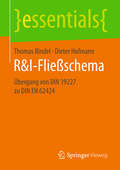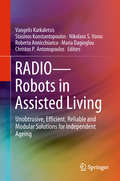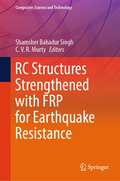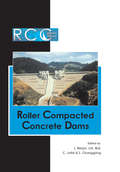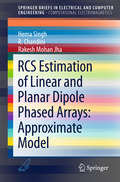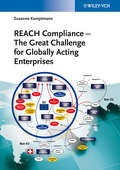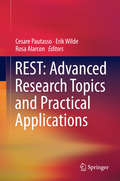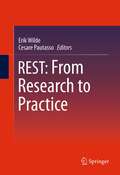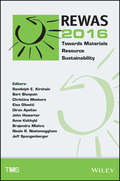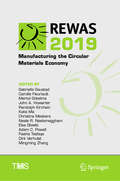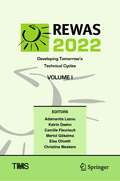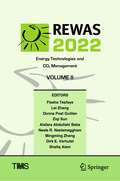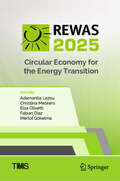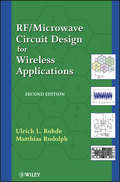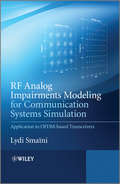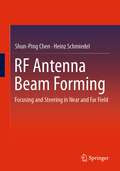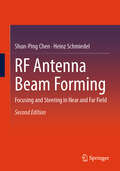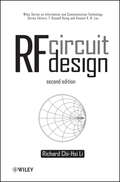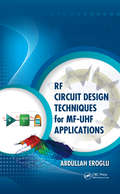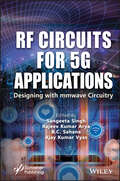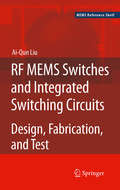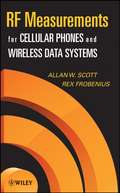- Table View
- List View
R&I-Fließschema: Übergang von DIN 19227 zu DIN EN 62424 (essentials)
by Dieter Hofmann Thomas BindelThomas Bindel und Dieter Hofmann arbeiten Gemeinsamkeiten und Unterschiede der Normen DIN 19227 und DIN EN 62424 für die Erarbeitung von R&I-Fließschemata/R&I-Fließbildern heraus. DIN 19227, Teil 1 (Graphische Symbole und Kennbuchstaben für die Prozeßleittechnik) wurde zurückgezogen und durch DIN EN 62424 (Darstellung von Aufgaben der Prozessleittechnik – Fließbilder und Datenaustausch zwischen EDV-Werkzeugen zur Fließbilderstellung und CAE-Systemen) ersetzt, galt jedoch bis Juli 2012 fort. Da Fließschemata älterer Anlagen nach DIN 19227 erarbeitet wurden, stehen Anwender vor der Herausforderung, diese Norm nach wie vor verstehen zu müssen, für neu errichtete Anlagen dagegen DIN EN 62424 anzuwenden, die sich eher zögerlich durchzusetzen scheint. Die Autoren beleuchten die mit dem Übergang verbundenen Änderungen und geben so Orientierung zur Nutzung von DIN EN 62424.
R.U.R. and the Vision of Artificial Life
by Karel CapekA new translation of Karel Čapek&’s play R.U.R.—which famously coined the term &“robot&”—and a collection of essays reflecting on the play&’s legacy from scientists and scholars who work in artificial life and robotics.Karel Čapek's &“R.U.R.&” and the Vision of Artificial Life offers a new, highly faithful translation by Štěpán Šimek of Czech novelist, playwright, and critic Karel Čapek&’s play R.U.R.: Rossum&’s Universal Robots, as well as twenty essays from contemporary writers on the 1920 play. R.U.R. is perhaps best known for first coining the term &“robot&” (in Czech, robota means serfdom or arduous drudgery). The twenty essays in this new English edition, beautifully edited by Jitka Čejková, are selected from Robot 100, an edited collection in Czech with perspectives from 100 contemporary voices that was published in 2020 to celebrate the hundredth anniversary of the play.Čapek&’s robots were autonomous beings, but biological, not mechanical, made of chemically synthesized soft matter resembling living tissue, like the synthetic humans in Blade Runner, Westworld, or Ex Machina. The contributors to the collection—scientists and other scholars—explore the legacy of the play and its connections to the current state of research in artificial life, or ALife. Throughout the book, it is impossible to ignore Čapek&’s prescience, as his century-old science fiction play raises contemporary questions with respect to robotics, synthetic biology, technology, artificial life, and artificial intelligence, anticipating many of the formidable challenges we face today.ContributorsJitka Čejková, Miguel Aguilera, Iñigo R. Arandia, Josh Bongard, Julyan Cartwright, Seth Bullock, Dominique Chen, Gusz Eiben, Tom Froese, Carlos Gershenson, Inman Harvey, Jana Horáková, Takashi Ikegami, Sina Khajehabdollahi, George Musser, Geoff Nitschke, Julie Nováková, Antoine Pasquali, Hemma Philamore, Lana Sinapayen, Hiroki Sayama, Nathaniel Virgo, Olaf Witkowski
RADIO--Robots in Assisted Living: Unobtrusive, Efficient, Reliable and Modular Solutions for Independent Ageing
by Nikolaos S. Voros Christos P. Antonopoulos Vangelis Karkaletsis Stasinos Konstantopoulos Roberta Annicchiarico Maria DagioglouThis book describes a unique approach to bring robotic technology into elders’ daily lives. Low cost components and low cost robotic assistants are effectively combined to offer high quality services to elders and people in need. The book presents in a comprehensive way how technology can be used for developing a new healthcare paradigm where high quality services are offered at home, thus reducing the ever-increasing hospitalization cost of the elders and the people with chronic diseases.
RC Structures Strengthened with FRP for Earthquake Resistance (Composites Science and Technology)
by Shamsher Bahadur Singh C. V. R. MurtyThis book covers the merits and demerits of advanced composite materials with regard to their applications for earthquake-resistant applications. The chapters in the book are divided into the following main topics: (a) the processing and fabrication of fiber-reinforced polymer composite materials, (b) the mechanical characteristics of materials, (c) the design of strengthening and reinforcing systems for earthquake resistance of the deficient structural system, and (d) design of new earthquake-resistant structures using advanced composite materials. The chapters present experimental tests and numerical modeling of responses of various kinds of structural elements for predicting the load versus deflection response, energy absorption capacity, ductility index, energy ratios, failure modes, and load capacity. It also looks at different kinds of composite systems and their hybrid or functionally graded composites using advanced composite materials, such as carbon fiber-reinforced polymer (CFRP), glass fiber-reinforced polymer (GFRP), aramid fiber-reinforced polymer (AFRP), basalt fiber-reinforced polymer (BFRP), and natural fiber-reinforced polymer (NFRP). The results presented in this book will be of high interest to scientists, researchers, students, and engineers working in the fields of advanced composite materials such as FRPs and other forms of composites for seismic retrofitting and strengthening of deficient structures. This book is helpful for teachers and (undergraduate, Master, and Ph.D.) students to develop a fundamental understanding of the design of earthquake-resistant design of structures (such as buildings, bridges, and industrial structures) using lightweight, durable, and sustainable FRP materials.
RCC Dams - Roller Compacted Concrete Dams: Proceedings of the IV International Symposium on Roller Compacted Concrete Dams, Madrid, Spain, 17-19 November 2003- 2 Vol set
by L. Berga & J.M. Buil, C. Jofré and S. ChonggangA book of broad interest to professionals, dam engineers and managers, and to organizations responsible for dam development and management, RCC Dams offers a topical account of the design and operation of roller compacted concrete dams, describing the latest developments and innovative technologies in the field. The book considers planning and design, materials and construction, as well as the operation and performance of RCC dams.
RCS Estimation of Linear and Planar Dipole Phased Arrays: Approximate Model
by Hema Singh Rakesh Mohan Jha R. ChandiniIn this book, the RCS of a parallel-fed linear and planar dipole array is derived using an approximate method. The signal propagation within the phased array system determines the radar cross section (RCS) of phased array. The reflection and transmission coefficients for a signal at different levels of the phased-in scattering array system depend on the impedance mismatch and the design parameters. Moreover the mutual coupling effect in between the antenna elements is an important factor. A phased array system comprises of radiating elements followed by phase shifters, couplers, and terminating load impedance. These components lead to respective impedances towards the incoming signal that travels through them before reaching receive port of the array system. In this book, the RCS is approximated in terms of array factor, neglecting the phase terms. The mutual coupling effect is taken into account. The dependence of the RCS pattern on the design parameters is analyzed. The approximate model is established as an efficient method for RCS estimation of phased arrays. This book presents a detailed formulation of approximate method to determine RCS of phased arrays, which is explained using schematics and illustrations. This book should help the reader understand the impinging signal path and its reflections/transmissions within the phased array system.
REACH Compliance
by Susanne KamptmannThe only book to not only discuss the technicalities of the European REACH chemicals registration process, but also to directly address the resulting business risks and business solutions.In this text for practitioners, the author pulls together the key knowledge needed to successfully run a business under REACH, distilling thousands of pages of official documentation, and incorporating experiences from different-sized enterprises in a global context.Starting with the basics of the REACH framework, she explains the entire process on how to register with the European ECHA office with a particular emphasis on small and medium-sized businesses. Along the way, she describes key milestones and presents sample documents from real case studies. The final part of the book addresses strategies to ensure a reach-compliant operation, including recommendations for in-house processes as well as communicating with suppliers and downstream users.As a result, managers in the pharmaceuticals and chemicals industries will learn how to operate their companies in full compliance with REACH standards.
REDIRECTING INNOVATION IN U.S. HEALTH CARE: Options to Decrease Spending and Increase Value
by Steven Garber Mary E. Vaiana Susan M. Gates Arthur L. Kellermann Emmett B. Keeler Andrew W. Mulcahy Christopher LauNew medical technologies are a leading driver of U. S. health care spending. This report identifies promising policy options to change which medical technologies are created, with two related policy goals: (1) Reduce total health care spending with the smallest possible loss of health benefits, and (2) ensure that new medical products that increase spending are accompanied by health benefits that are worth the spending increases.
REST: Advanced Research Topics and Practical Applications
by Cesare Pautasso Erik Wilde Rosa AlarconThis book serves as a starting point for people looking for a deeper principled understanding of REST, its applications, its limitations, and current research work in the area and as an architectural style. The authors focus on applying REST beyond Web applications (i. e. , in enterprise environments), and in reusing established and well-understood design patterns. The book examines how RESTful systems can be designed and deployed, and what the results are in terms of benefits and challenges encountered in the process. This book is intended for information and service architects and designers who are interested in learning about REST, how it is applied, and how it is being advanced.
REST: From Research to Practice
by Cesare Pautasso Erik WildeThis volume provides an overview and an understanding of REST (Representational State Transfer). Discussing the constraints of REST the book focuses on REST as a type of web architectural style. The focus is on applying REST beyond Web applications (i.e., in enterprise environments), and in reusing established and well-understood design patterns when doing so. The reader will be able to understand how RESTful systems can be designed and deployed, and what the results are in terms of benefits and challenges encountered in the process. Since REST is relatively new as an approach for designing Web Services, the more advanced part of the book collects a number of challenges to some of the assumptions and constraints of REST, and looks at current research work on how REST can be extended and applied to scenarios that often are considered not to be a good match for REST. This work will help readers to reach a deeper understanding of REST on a practical as well as on an advanced level.
REWAS 2016: Towards Materials Resource Sustainability
by Diran Apelian Brajendra Mishra Neale R. Neelameggham John Howarter Elsa Olivetti Anne Kvithyld Christina E. Meskers Jeffrey S. Spangenberger Bart Blanpain Randolph E. KirchainTopics covered in REWAS 2016 include: Enabling & Understanding Sustainability - Ferrous & Non-ferrous Metals Processing Understanding & Enabling Sustainability - (Rechargeable) Batteries Enabling & Understanding Sustainability - Rare Earth Element Applications Enabling & Understanding Sustainability - Building Materials & Slag Valorisation Designing Materials and Systems for Sustainability Understanding & Enabling Sustainability - Light Metals Recycling & Waste Valorisation Understanding & Enabling Sustainability - Education Research Innovation I Understanding & Enabling Sustainability - Education Research Innovation II + Electronic Equipment
REWAS 2019: Manufacturing the Circular Materials Economy (The Minerals, Metals & Materials Series)
by Neale R. Neelameggham Mingming Zhang Elsa Olivetti Fiseha Tesfaye John A. Howarter Dirk Verhulst Gabrielle Gaustad Camille Fleuriault Mertol Gökelma Randolph Kirchain Kaka Ma Christina Meskers Adam C. PowellEvery sector faces unique challenges in the transition to sustainability. Across each, materials will play a key role. That will depend on novel materials and processes, but these will only be effective with a solid understanding of the trends in the market. For each respective sector, the papers in this collection will explore the trends and drivers toward sustainability, the enabling materials technologies and challenges, and the tools to evaluate their implications. Major sections in REWAS 2019 include: Disruptive Material Manufacturing: Scaling and Systems Challenges Education and Workforce Development Rethinking Production Secondary and Byproduct Sources of Materials, Minerals, and Metals
REWAS 2022: Developing Tomorrow’s Technical Cycles (The Minerals, Metals & Materials Series)
by Elsa Olivetti Camille Fleuriault Mertol Gökelma Christina Meskers Adamantia Lazou Katrin DaehnThe 7th installment of the REWAS conference series held at the TMS Annual Meeting& Exhibition focuses on developing tomorrow’s technical cycles. The papers in thiscollection explore the latest technical and societal developments enabling sustainabilitywithin our global economy with an emphasis on recycling and waste management. The2022 collection includes contributions from the following symposia:• Coupling Metallurgy and Sustainability: An EPD Symposium in Honor of Diran Apelian• Recovering the Unrecoverable• Sustainable Production and Development Perspectives• Automation and Digitalization for Advanced Manufacturing• Decarbonizing the Materials Industry
REWAS 2022: Energy Technologies and CO2 Management (The Minerals, Metals & Materials Series)
by Lei Zhang Neale R. Neelameggham Mingming Zhang Dirk E. Verhulst Donna Post Guillen Shafiq Alam Ziqi Sun Fiseha Tesfaye Alafara Abdullahi BabaThe reliance on fossil fuels for energy is unsustainable and has released an unprecedentedamount of carbon dioxide into our atmosphere. The continual research and developmenteffort into clean and sustainable energy technologies is of paramount importance toensure the responsible progress of human civilization and innovations. This collection,with authors representing industry, government, and academia, focuses on energyefficient technologies including innovative ore beneficiation, smelting technologies,recycling and waste heat recovery, and emerging novel energy technologies. Thesymposium also covers various technological aspects of sustainable energy ecosystems,processes that improve energy efficiency and reduce thermal emissions.Topics include:• Renewable Energy and Combustion Technologies• Energy Efficiency, Decarbonization and CO2 Management• Thermal Management and Hydrogen Technology
REWAS 2025: Circular Economy for the Energy Transition (The Minerals, Metals & Materials Series)
by Elsa Olivetti Mertol Gökelma Christina Meskers Adamantia Lazou Fabian DiazThe 8th installment of the REWAS conference series held at the TMS Annual Meeting & Exhibition focuses on circular economy for the energy transition. The papers in this volume explore the latest technical and societal developments enabling sustainability within our global economy with an emphasis on recycling and waste management. The 2025 collection includes contributions from the following symposia: Automation and Digitalization in Recycling Processes Sustainable End-of-Life Management and Recycling Solutions for Batteries, Wind Turbines, and Photovoltaics Sustainable Practices in Strategic and Critical Raw Materials: Exploring Supply Chain Resilience and Recycling Innovations
RF / Microwave Circuit Design for Wireless Applications
by Ulrich L. Rohde Matthias RudolphProvides researchers and engineers with a complete set of modeling, design, and implementation tools for tackling the newest IC technologiesRevised and completely updated, RF/Microwave Circuit Design for Wireless Applications, Second Edition is a unique, state-of-the-art guide to wireless integrated circuit design that provides researchers and engineers with a complete set of modeling, design, and implementation tools for tackling even the newest IC technologies. It emphasizes practical design solutions for high-performance devices and circuitry, incorporating ample examples of novel and clever circuits from high-profile companies.Complete with excellent appendices containing working models and CAD-based applications, this powerful one-stop resource:Covers the entire area of circuit design for wireless applicationsDiscusses the complete system for which circuits are designed as well as the device technologies on which the devices and circuits are basedPresents theory as well as practical issuesIntroduces wireless systems and modulation typesTakes a systematic approach that differentiates between designing for battery-operated devices and base-station designRF/Microwave Circuit Design for Wireless Applications, Second Edition is an indispensable tool for circuit designers; engineers who design wireless communications systems; and researchers in semiconductor technologies, telecommunications, and wireless transmission systems.
RF Analog Impairments Modeling for Communication Systems Simulation
by Lydi SmainiWith the growing complexity of personal mobile communication systems demanding higher data-rates and high levels of integration using low-cost CMOS technology, overall system performance has become more sensitive to RF analog front-end impairments. Designing integrated transceivers requires a thorough understanding of the whole transceiver chain including RF analog front-end and digital baseband. Communication system engineers have to include RF analog imperfections in their simulation benches in order to study and quantify their impact on the system performance.Here the author explores key RF analog impairments in a transceiver and demonstrates how to model their impact from a communication system design view-point. He discusses the design aspects of the front end of transceivers (both receivers and transmitters) and provides the reader with a way to optimize a complex mixed-signal platform by taking into account the characteristics of the RF/analog front-end.Key features of this book include:Practical examples illustrated by system simulation results based on WiFi and mobile WiMAX OFDM transceiversAn overview of the digital estimation and compensation of the RF analog impairments such as power amplifier distortion, quadrature imbalance, and carrier and sampling frequency offsetsAn exposition of the challenges involved in the design of both RF analog circuits and DSP communication circuits in deep submicron CMOS technologyMATLAB® codes for RF analog impairments models hosted on the companion websiteUniquely the book bridges the gap between RFIC design specification needs and communication systems simulation, offering readers RF analog impairments modeling knowledge and a comprehensive approach to unifying theory and practice in system modelling. It is of great value to communication systems and DSP engineers and graduate students who design communication processing engines, RF/analog systems and IC design engineers involved in the design of communication platforms.
RF Antenna Beam Forming: Focusing and Steering in Near and Far Field
by Shun-Ping Chen Heinz SchmiedelThis book is designed for both the scientific audience, research and development engineers and the university students. The fundamentals of radio frequency antenna beam forming is explained in this book. The principles of beam focusing and beam steering in near field and far field are visualized with 2D and 3D simulations and compared with measurement results. Besides linear and planar antenna arrays, also conformal arrays, i.e. concave and convex antenna arrays, suitable for certain applications, are investigated and presented. Also related applications of radio frequency beam forming like open loop and closed loop large scale antenna arrays or massive MIMO, which is one of the break-through technologies for 5G and future 6G and involves an extremely large number of antenna elements for the multi-user beam forming, as well as thinned antenna arrays with electrically large distances between the antenna elements are discussed.
RF Antenna Beam Forming: Focusing and Steering in Near and Far Field
by Shun-Ping Chen Heinz SchmiedelThis book is designed for both the scientific audience, research and development engineers and university students. The fundamentals of radio frequency antenna beam forming are explained in this book. The principles of beam focusing and beam steering in near field and far field are visualized with 2D and 3D simulations and compared with measurement results. Besides linear and planar antenna arrays, also conformal arrays, i.e. concave and convex antenna arrays, suitable for certain applications, are investigated and presented. Also related applications of open loop and closed loop beam forming, and massive MIMO, which is one of the break-through technologies for 5G and future 6G and involves an extremely large number of antenna elements for the multi-user beam forming, are discussed in detail. Also covered are large scale antenna arrays as well as thinned antenna arrays with electrically large distances between the antenna elements.
RF CMOS Oscillators for Modern Wireless Applications (River Publishers Series In Circuits And Systems Ser.)
by Robert Bogdan Staszewski Masoud Babaie Mina ShahmohammadiWhile mobile phones enjoy the largest production volume ever of any consumer electronics products, the demands they place on radio-frequency (RF) transceivers are particularly aggressive, especially on integration with digital processors, low area, low power consumption, while being robust against process-voltage-temperature variations. Since mobile terminals inherently operate on batteries, their power budget is severely constrained. To keep up with the ever increasing data-rate, an ever-decreasing power per bit is required to maintain the battery lifetime. The RF oscillator is the second most power-hungry block of a wireless radio (after power amplifiers). Consequently, any power reduction in an RF oscillator will greatly benefit the overall power efficiency of the cellular transceiver. Moreover, the RF oscillators' purity limits the transceiver performance. The oscillator's phase noise results in power leakage into adjacent channels in a transmit mode and reciprocal mixing in a receive mode. On the other hand, the multi-standard and multi-band transceivers that are now trending demand wide tuning range oscillators. However, broadening the oscillator’s tuning range is usually at the expense of die area (cost) or phase noise.The main goal of this book is to bring forth the exciting and innovative RF oscillator structures that demonstrate better phase noise performance, lower cost, and higher power efficiency than currently achievable. Technical topics discussed in RF CMOS Oscillators for Modern Wireless Applications include: Design and analysis of low phase-noise class-F oscillators Analyze a technique to reduce 1/f noise up-conversion in the oscillators Design and analysis of low power/low voltage oscillators Wide tuning range oscillators Reliability study of RF oscillators in nanoscale CMOS
RF Circuit Design (Information and Communication Technology Series, #102)
by Richard C. LiSummarizes the schemes and technologies in RF circuit design, describes the basic parameters of an RF system and the fundamentals of RF system design, and presents an introduction of the individual RF circuit block design. Forming the backbone of today's mobile and satellite communications networks, radio frequency (RF) components and circuits are incorporated into everything that transmits or receives a radio wave, such as mobile phones, radio, WiFi, and walkie talkies. RF Circuit Design, Second Edition immerses practicing and aspiring industry professionals in the complex world of RF design. Completely restructured and reorganized with new content, end-of-chapter exercises, illustrations, and an appendix, the book presents integral information in three complete sections: Part One explains the different methodologies between RF and digital circuit design and covers voltage and power transportation, impedance matching in narrow-band case and wide-band case, gain of a raw device, measurement, and grounding. It also goes over equipotentiality and current coupling on ground surface, as well as layout and packaging, manufacturability of product design, and radio frequency integrated circuit (RFIC). Part Two includes content on the main parameters and system analysis in RF circuit design, the fundamentals of differential pair and common-mode rejection ratio (CMRR), Balun, and system-on-a-chip (SOC). Part Three covers low-noise amplifier (LNA), power amplifier (PA), voltage-controlled oscillator (VCO), mixers, and tunable filters. RF Circuit Design, Second Edition is an ideal book for engineers and managers who work in RF circuit design and for courses in electrical or electronic engineering.
RF Circuit Design Techniques for MF-UHF Applications
by Abdullah ErogluMagnetic resonance imaging, semiconductor processing, and RFID are some of the critical applications within the medium frequency (MF) to ultrahigh frequency (UHF) range that require RF designers to have a solid understanding of analytical and experimental RF techniques. Designers need to be able to design components and devices cost effectively, and integrate them with high efficiency, minimal loss, and required power. Computer-aided design (CAD) tools also play an important part in helping to reduce costs and improve accuracy through optimization. RF Circuit Design Techniques for MF-UHF Applications explains how to design, simulate, and implement RF/microwave components and devices for applications within the medium frequency (MF) to ultrahigh frequency (UHF) range. The book makes RF design simple by expertly blending theory, simulation, and practical application examples. A Practical Guide to RF Circuit Design in the MF-UHF Range: Theory, Simulation, and Real-World Application Examples After a review of network parameters used in the analysis of RF components and devices, the book examines MF-UHF design techniques in detail. These include techniques for designing high-power microstrip circuits, directional couplers, transformers, composite and multilayer inductors, filters, combiners/dividers, and RFID systems. For every device, the book gives the required theory and then explains the verification process with CAD tools. In addition, each design is illustrated with real-life implementation examples that use a variety of CAD tools such as MATLAB®, Mathcad, HFSS™, Ansoft Designer®, Sonnet®, and PSpice®. Design tables, curves, and charts are included to demonstrate an efficient design process. Throughout, the book also offers practical hints to help engineers shorten the design time. Design MF-UHF Devices More Cost-Effectively The book reflects the optimum design methodology used in RF engineering, from the application of theory, to simulation for verification, to experimentation. Packed with useful techniques, tips, and examples, it is an invaluable resource for engineers, researchers, and students working in the MF-UHF range.
RF Circuits for 5G Applications: Designing with mmWave Circuitry
by B. C. Sahana Sangeeta Singh Ajay Kumar Vyas Rajeev Kumar AryaRF CIRCUITS FOR 5G APPLICATIONS This book addresses FinFET-based analog IC designing for fifth generation (5G) communication networks and highlights the latest advances, problems, and challenges while presenting the latest research results in the field of mmwave integrated circuits designing. The wireless communication sector is experiencing exponential expansion, particularly in the areas of mobile data and the 5G mobile network, creating fresh market possibilities for designing the integrated circuits (ICs) needed in the industry. Drawing from scientific literature and practical realization, this book explores FinFET-based analog IC designing for 5G communication networks and considers the latest breakthroughs and obstacles. It also presents the recent research trends and future roadmaps for the 5G communication circuits. RF Circuits for 5G Applications includes design guidelines to be considered when designing these circuits and detrimental scaling effects of the same. In addition, to enhance the usability of this book, the editors have included real-time problems in RFIC designing and case studies from experimental results, as well as clearly demarcated design guidelines for the 5G communication ICs designing. Audience The primary target audience includes researchers, postgraduate students, and industry professionals pursuing specializations in RF engineering, electronics engineering, electrical engineering, information, and communication technology.
RF MEMS Switches and Integrated Switching Circuits
by Ai-Qun LiuMicroelectromechanical Systems (MEMS) stand poised for the next major breakthrough in the silicon revolution that began with the transistor in the 1960s and has revolutionized microelectronics. MEMS allow one to not only observe and process information of all types from small scale systems, but also to affect changes in systems and the environment at that scale. "RF MEMS Switches and Integrated Switching Circuits" builds on the extensive body of literature that exists in research papers on analytical and numerical modeling and design based on RF MEMS switches and micromachined switching circuits, and presents a unified framework of coverage. This volume includes, but is not limited to, RF MEMS approaches, developments from RF MEMS switches to RF switching circuits, and MEMS switch components in circuit systems. This book also: -Presents RF Switches and switching circuit MEMS devices in a unified framework covering all aspects of engineering innovation, design, modeling, fabrication, control and experimental implementation -Discusses RF switch devices in detail, with both system and component-level circuit integration using micro- and nano-fabrication techniques -Includes an emphasis on design innovation and experimental relevance rather than basic electromagnetic theory and device physics "RF MEMS Switches and Integrated Switching Circuits" is perfect for engineers, researchers and students working in the fields of MEMS, circuits and systems and RFs.
RF Measurements for Cellular Phones and Wireless Data Systems
by Allen W. Scott Rex FrobeniusThe only source for practical, real-world information on RF measurements for cellular phones and wireless data systemsIt is predicted that by the year 2010, all digital wireless communications equipment--including cellular, PCS, and 3G phones; wireless LANs; GPS navigation systems; and DBS TV--will have data transfer capabilities of over 1 Mbps. Now, as this significant turning point quickly approaches, this book presents everything industry professionals need to know about the Radio Frequency (RF) measurements and tests that must be made on this new generation of digital wireless communications equipment.Presenting just enough theory as is absolutely required for comprehension, RF Measurements for Cellular Phones and Wireless Data Systems:Provides a review of basic RF principles and terminologyDescribes RF measurement equipment, including signal generators, power meters, frequency meters, vector network analyzers, spectrum analyzers, and vector signal analyzersExplains the RF devices that are used in cellular phones and wireless data transmission equipment--how they work, what their critical performance parameters are, how they're tested, and typical test resultsIllustrates the testing of RF devices and systems with digitally modulated signals that represent the voice, video, or data that the RF wave is carryingRF Measurements for Cellular Phones and Wireless Data Systems has been written to serve as the industry standard for RF measurements and testing. It is an indispensable resource for engineers, technicians, and managers involved in the construction, installation, or maintenance of cell phones and wireless data equipment.
